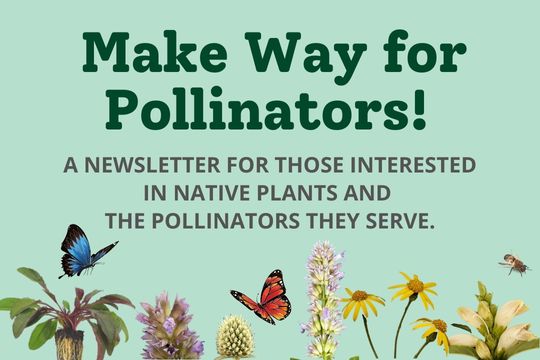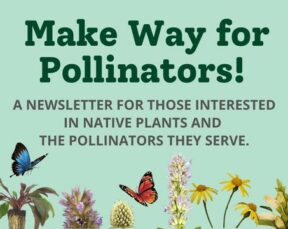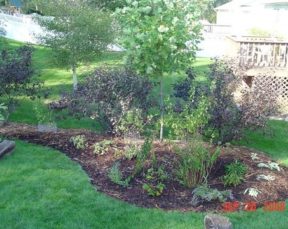Make Way for Pollinators, February 2023
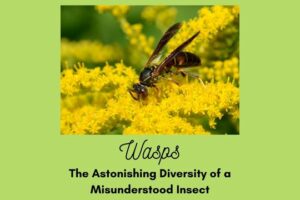

Off the heels of a fascinating talk in January from Desiree Narango (you can retroactively register for this talk to receive the recording at greatswamp.org/events) our speaker series continues in February with Eric Eaton, who will talk about Wasps – The Astonishing Diversity of a Misunderstood Insect. Eric will shed more light on the insect people love to hate, but which is an invaluable aid to the ecosystem. Eric will deconstruct our misconceptions about the often-vilified wasps and also challenge us to shift the outdated mindset of what really constitutes a “yard” or “garden” and help homeowners think more holistically about what really constitute beneficial species. The talk takes place February 21 at 7:00 pm – 8:00 pm, Zoom Webinar. While these talks are free, we really encourage a suggested $5-$10 donation to offset our costs of bringing these nationally acclaimed speakers to you. CLICK HERE to sign up for this or all of the remaining webinars. For more 2/21 webinar details and to register today, you can go to https://bit.ly/3ISyTnJ.
Howdy Neighbor
Many native bees live their entire lives in a 5000-foot diameter range. Other solitary bees travel much longer distances, foraging in different spots daily to maximize nectar and pollen intake. There are more than 4,000 species of native bees in the United States, all helpfully pollinating your vegetables, fruits and flowers around your yard. We know that these native bees are in trouble, as study after study shows sharp declines in their numbers due to habitat loss and overabundant pesticide use in our suburban and rural communities. National wildlife Federation research shows some butterfly species have declined by more than 90% in the last two decades.


Foraging in your yard, filled with fabulous native plants from our sale, bees will be able to find great sources of nectar and pollen – but what’s happening over the fence in your neighbor’s yard? Are there pollen and other bee and butterfly friendly resources that will help pollinators move seamlessly through a neighborhood between high value patches of habitat? Connectivity is key for native pollinators to thrive. Think of those perennials in your native plant gardens as charging stations for insects, offering nectaring waystations and resting stops as pollinators move around to the highest value resources.
What could you do to encourage your neighbors, the friend on the next street, or the new house owner just moved in across the way to understand the value of providing native plants for local area wildlife? You could consider planting a hell strip garden, right out front, where neighbors out walking will see your beautiful plants, perhaps with the addition of a pollinator pathway sign, and stop to ask what you are doing. WE are selling such a kit this year, that will supply long blooming plants for the tough strip between sidewalk and street. You can divide larger perennials and offer them some free plants that will bolster the resources your patch of the pollinator pathway may provide. Consider telling them about our plant sale, share the link to this newsletter, or offer to help them make decisions on what will grow well in their yards, or even share plant collection and planting duties. Our backyards need to slowly connect to a network of pollinator and wildlife friendly gardens linking larger patches of forest- be a part of that solution. More information on the concept of Pollinator pathways can be found at www.pollinator-pathway.org
Kits! We have New and exciting Kit news!
We are happy to announce that this year’s Native Plants for Pollinators Plant sale will include 36 standalone species and 6 kits we have put together for a broad array of conditions found in yards across our region. We have responded to customer feedback from the last sale and expanded our plant list for an even broader array of tough garden growing conditions- especially dry shade, as well as a hell strip kit that thrives in full sun and dry soils, three different kits positioned to do well in sun and average to moist soils, and lastly a rain basin kit whose plants will thrive in sun and tolerate those wetter soils.
You can purchase each kit as a standalone garden- it will come with a helpful kit guide to give you all the information you will need on how to take care of your fledgling native plant garden, including when and how the plants will grow and bloom, what pollinators they might attract, and suggestions for their planting arrangement, care, and maintenance. You can take our planting design suggestions or incorporate the plant plugs as you like into new or existing gardens, or in tandem with other kits we are selling. Many of our kits work particularly well together, supporting broad ranges of floral shape, color, bloom time and pollinator benefit. Below, to whet your appetite and help you plan are the descriptions of the kit component species. See below for more information about our kits and see the list of all the 2023 native plants on our website at greatswamp.org/native-plant-sale.
Dry Shade: This kit is perfect for those tough conditions of well-drained, drier shade in the garden, and could be augmented with some of our individual shade-loving species to provide a fantastic season-long feast for pollinators. In the spring, the white flowers of low-growing stonecrop begin to bloom, supplemented later in spring with the star-shaped flowers of curly wood sedge. In late summer and into fall, drifts of white wood aster and wreath goldenrod will bloom brilliantly together for weeks. Coralbells provide some evergreen groundcover, adding cream-colored blooms in the fall.
Sidewalk/Container: We’ve selected these natives to address those dry, full sun and tough garden conditions such as the “hell strip,” area between sidewalk and road, or the large patio container or thin soil and full blazing sunspot in the yard. This kit contains tough, hardy plants that are drought, salt, and trample-tolerant and will thrive in the most difficult of conditions. In early spring, blue trumpet-like flowers rise from the evergreen rosettes of fragrant lyre leaf sage. This plant will also self-sow to fill in the gaps in the garden. The felty foliage and intriguing white flowers of pussytoes bloom in late spring, helping suppress weeds with their groundcover growth habit, while ever-blooming black-eyed Susan begins in the spring and continues throughout the summer serving numerous pollinators and seed-eating birds. Purple lovegrass, with its unique form and purplish pink fall color looks great throughout the growing season and rounds out this workhorse kit.
Red, White and Blues: The Red, White and Blues Kit begins blooming in late spring, with the magnificent and showy blue spikes of shining blue star provides valuable nectar to early spring pollinators while scarlet beebalm and culver’s root bloom throughout the summer providing nectar and larval food for many diverse pollinators. Fall brings on the brilliant sunny yellows of showy goldenrod and the unusual purple red flowerheads of seeding side oats grama.
Pink, Purple, and Yellows: This kit provides much needed splashes of brilliant color in the yard as long blooming lance leaf coreopsis begins to bloom in the late spring and continues throughout the summer. The blue plumes of anise hyssop and legion white flowers of the fragrant blunt mountain mint pick up the color show later in the summer and into fall, acting as pollinator workhorses, attracting many different types of pollen and nectar feeding insects. Lastly, the amazing, yellow-eyed deep purple and prolific flowers of New England aster bloom throughout the fall until frost as a grand finale.
Best Behaved: This kit is perfect for gardeners who love the idea of natives but want to have a pollinator garden that doesn’t necessarily look like a pollinator garden! We have selected these plants specifically to be lower growing and less spreading in growth habit. Watch as hummingbirds and early pollinators flock to blooming columbine in spring, giving way to tall anemone and wild quinine blooming long into summer. Plumes of purple feather- like blossoms will attract many native bees as dense blazing star takes over the garden in mid-summer, with the long-lasting sturdy purple coneflowers bringing your garden into the fall until frost with their showy blooms and bird-feeding seedheads.
Rain Basin: This rain basin kit filled with moisture-loving species is perfect for the wet garden, low-lying damp spot, or can be combined with drier-loving species to make the foundations of a rain garden planting. In spring, the large, eye-popping flowers of blue flag iris will appeal to bees and early pollinators while Eastern star sedge’s smaller, star-like green flowers appear to support different pollinators. As summer heats up, the fragrant pink clusters of joe-pye weed attract a variety of pollinators and host caterpillars, acting as the backbone of this pollinator garden, while the vibrant red tube-like cardinal flower blooms of late summer act as hummingbird magnets to migrating birds and long tongued moths and butterflies. In fall, Eastern star sedge flowers will give way to numerous seeds for wildlife, while clusters of white turtleheads bloom, attracting two-spotted long-horned bees and numerous species of bumblebees.
Early Bloomers
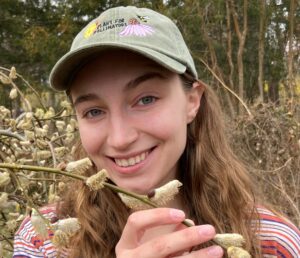

Take a walk outside and see what your yard is offering for these hardy early fliers?
While there are no native perennials that bloom through winter, some of our hard-working native shrubs can offer early ground nesting bees important nectar and pollen resources.
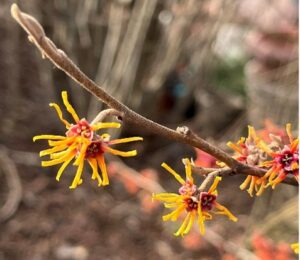

Native willows- such as pussy willow, or indeed any of the many tree willows (Salix species) offer vital pollen supplies to other early flying insects as they emerge in late winter and early spring. Willows are also fantastic larval hosts for a bunch of butterfly and moth species, so by planting a willow, you reap a double benefit. Willows respond well to hard cutbacks, and can produce elegant multiple stemmed shrubs, with profuse silky soft ‘pussy tails’ from which the pollen sacs emerge.
While bees, especially bumble bees and other large solitary bees will visit emerging crocus, squill and snowdrops, many of these non-native bulbs have been hybridized or bred to double petals, often at the expense of pollen or nectaries. So, while you wait for your chance to plant pollinator friendly perennials from our sale, consider enhancing your yards year round appeal with a winter blooming shrub or two. The bees will thank you!
